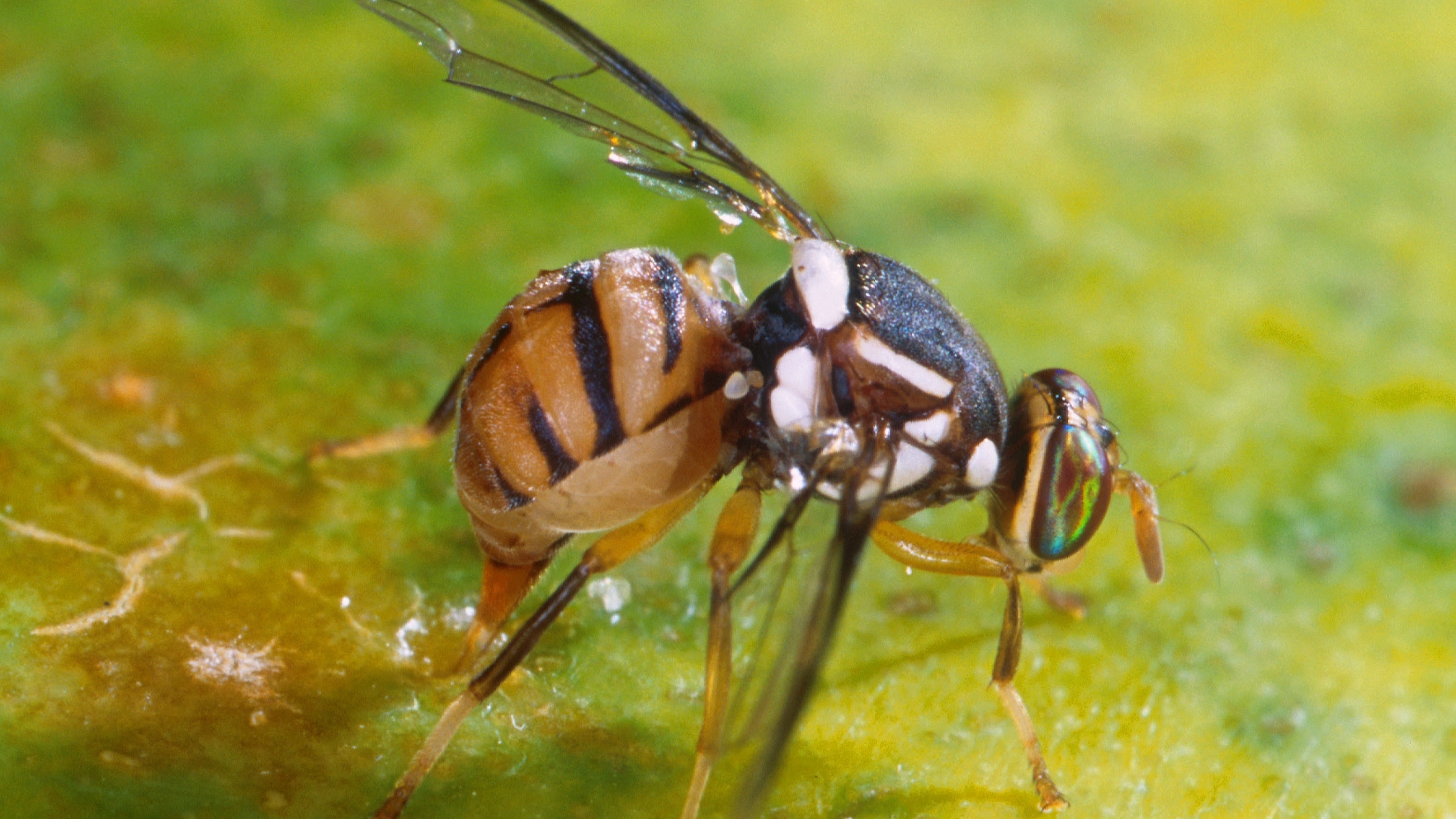Oriental Fruit Fly

The oriental fruit fly (Bactrocera dorsalis) is a destructive agricultural pest which attacks more than 400 types of fruits and vegetables, including apricots, cherries, figs, and tomatoes. It poses a serious and constant threat to U.S. agriculture due to its wide host range and ability to spread rapidly.
The oriental fruit fly is widespread throughout much of the mainland of Southern Asia, neighboring islands, and in Africa. It was first found in Hawaii in the mid-1940s, and later on the U.S. mainland in California and Florida. Detections in California have increased over the past decade as international passenger air travel has increased.
- Appearance
- Larvae (maggots) feed inside the fruit. They are legless, white to yellowish-white, and grow to a length of 0.4 inches.
- Adult oriental fruit flies are somewhat larger than a house fly. The body color is variable but generally has bright yellow markings and a dark T-shaped marking on the abdomen. The wings are clear.
- Females also have a pointed, slender, tube-like organ called an ovipositor. They use this to deposit eggs beneath the fruit's skin. Eggs are white, very small, and shaped like cylinders.
- Damage
- Fruit decays early and falls to the ground as the larvae develop and feed on the pulp.
The oriental fruit fly spreads mainly through infested fruits and vegetables. Here's what you can do to help prevent this pest:
- Fresh fruits, vegetables, or plants shouldn't be brought into or mailed to your State or another State unless agricultural inspectors have cleared them first.
- When returning from international travel, declare all agricultural products to U.S. customs officials. Learn more on our Traveler Information page.
- Know and follow all quarantine restrictions in fruit fly-infested areas.
- Never remove fresh produce from your property if your area is under a fruit fly quarantine.
- Fruits and vegetables may be consumed or processed (juiced, frozen, cooked, or ground in the garbage disposal) at the property of origin. If not consumed or processed, double-bag fruits and vegetables in plastic bags before throwing them away.
- Cooperate with agriculture officials who may be in your area surveying for the pest. We may ask for access to your property to place and check insect-monitoring traps.
Report Plant Pests and Diseases
Have you seen this pest or signs of pest damage? Immediately report your findings to your State plant health director or State plant regulatory official.
If you suspect that you have an oriental fruit fly infestation, contact your local cooperative extension service for advice. Please cooperate with local, State, and Federal agricultural officials as they carry out their work.
Controlling Oriental Fruit Fly
The oriental fruit fly is established in Hawaii, and the entire State is under quarantine for the pest. It is periodically detected in Florida and regularly detected in California. APHIS and the California Department of Food and Agriculture establish oriental fruit fly quarantines per the Cooperative Fruit Fly Emergency Response Triggers & Guidelines (198.25 KB).
For the latest oriental fruit fly quarantine information, select the name of your State in the Pest Tracker below, or view Fruit Fly Quarantine Maps and Descriptions and Fruit Fly Federal Orders and SPRO Letters.
Pest Tracker: Find Pests by State or Region
Find out if your State has a Federal quarantine and/or State-level quarantine for any hungry pests.
APHIS rapidly responds to oriental fruit fly incursions in the United States. We follow program guidelines (198.25 KB) that address survey, treatment, and regulatory response and meet National Environmental Policy Act requirements and other applicable laws and regulations.
When we detect oriental fruit fly in an area, we work with State partners using a tiered approach. Our efforts may include surveying to delimit the extent of the incursion, inspecting fruit and other host plants, setting and monitoring traps, conducting public outreach, and establishing a parallel Federal-State quarantine in the affected area.
When an oriental fruit fly outbreak occurs, we take immediate action to eradicate the pest.
- Brochure: Invasive Fruit Flies Impact You / Las plagas de moscas de la fruta lo afectan a usted (2.07 MB)
- Featured Creatures: Oriental Fruit Fly (University of Florida)

